There are three ways to get supplies from Lukla to other parts of the Himalaya, helicopter, beasts of burden (which will be another post) and…humans. They are called porters, often mistakenly called Sherpas. We were told a Sherpa, which is an ethnicity, would not stoop so low as to carry gear at these altitudes. Therefore, the job of porter lies on others in the region looking for a job. This definition, I believe, changes as one climbs beyond base camp and heads to the summit of the big mountains. This blog will cover the space between Lukla and Base Camp.
Let’s begin with footwear. We agonized over what boots to wear that would be comfortable for this trek. Once on the trail that was it, no calling on the phone and having REI send a new pair. So, do we take a spare pair of boots? Some did, I did not. It worked out. I was shocked at the footwear of the porters. Shocked.
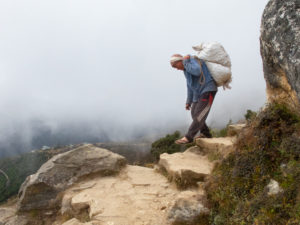 They wore flip-flops…
They wore flip-flops…
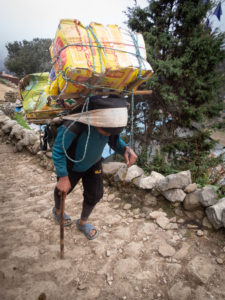 …slide in sandals…
…slide in sandals… 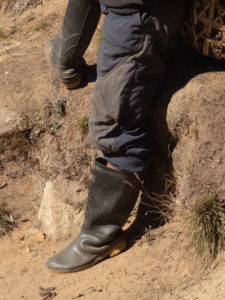 …and rubber boots.
…and rubber boots.
The loads they carried were remarkable. We were limited as to what we could bring, weight wise, for our porters. Each porter carried two of our bags. Our duffels contained clothes, toiletries and a sleeping bag for a 12-day trek. I think they each weighed 25-30 pounds which meant our porters were carrying 50-60 pounds PLUS their own gear. Which no doubt was FAR less than what we thought we needed to survive.
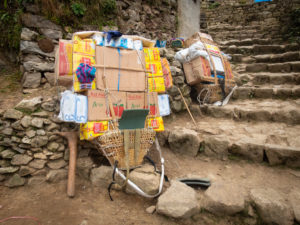 I have no idea what is in these boxes and packages but this looks like it must weigh FAR more than 60 pounds.
I have no idea what is in these boxes and packages but this looks like it must weigh FAR more than 60 pounds.
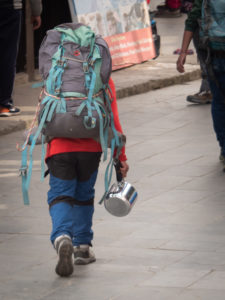 I found this interesting. See the belt strap on this backpack? It’s meant to distribute the weight of the pack to the hips thus alleviating strain on the shoulders, right? It’s not connected. The porters carry their weight with a strap across their heads. It didn’t matter if it was a backpack or traditional basket.
I found this interesting. See the belt strap on this backpack? It’s meant to distribute the weight of the pack to the hips thus alleviating strain on the shoulders, right? It’s not connected. The porters carry their weight with a strap across their heads. It didn’t matter if it was a backpack or traditional basket.
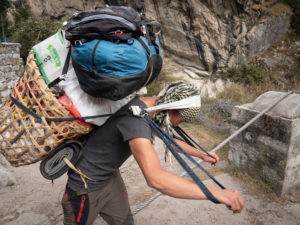 The straps he’s holding are used to balance the load.
The straps he’s holding are used to balance the load.
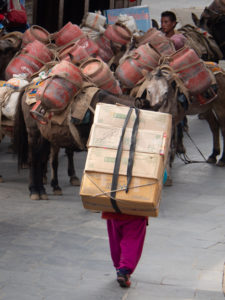 This guy is walking through Lukla and approaching a mule train loaded with propane tanks. I can’t help but wonder how far he’s going. The other amazing thing? We walked with daypacks full of water and extra clothing. The porters seemed to have nothing.
This guy is walking through Lukla and approaching a mule train loaded with propane tanks. I can’t help but wonder how far he’s going. The other amazing thing? We walked with daypacks full of water and extra clothing. The porters seemed to have nothing.
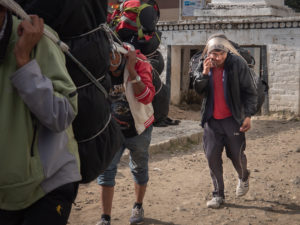
I think I’ve mentioned before that phones were common all along the trail.
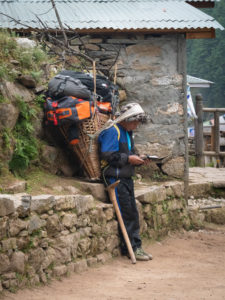 It seems this guy may have been setting up his next job.
It seems this guy may have been setting up his next job.
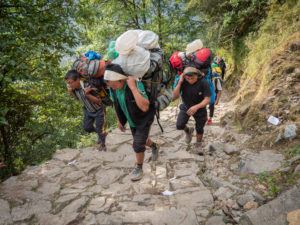 As with the animal pack trains, we always stepped out of the way and let the porters have a clear path with their loads.
As with the animal pack trains, we always stepped out of the way and let the porters have a clear path with their loads.
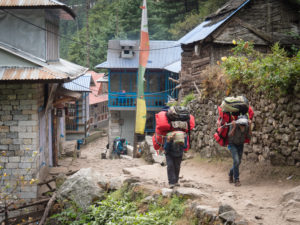 SUCH a common sight.
SUCH a common sight.
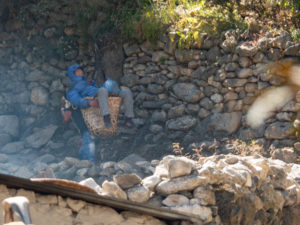 Not sure of the story here, maybe illness? injury? This porter was carrying a human!
Not sure of the story here, maybe illness? injury? This porter was carrying a human!
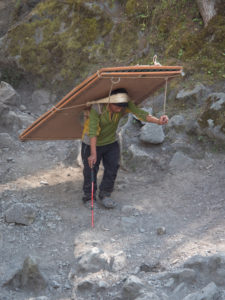 This was one of the more odd materials being transported up the trail.
This was one of the more odd materials being transported up the trail.
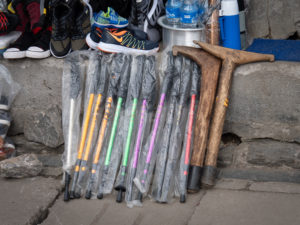
Hiking poles and…wooden crutches? I was curious about these items, most porters had them. Then I found this fellow:
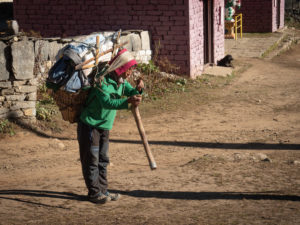
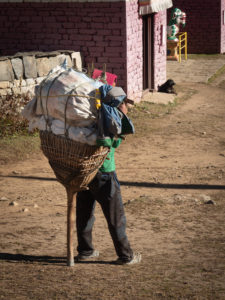 Genius! You can rest ANYWHERE!! All along the trail are low rock walls, largely built maybe for porters to rest their loads. But if there isn’t a wall there is the little wooden crutch!
Genius! You can rest ANYWHERE!! All along the trail are low rock walls, largely built maybe for porters to rest their loads. But if there isn’t a wall there is the little wooden crutch!
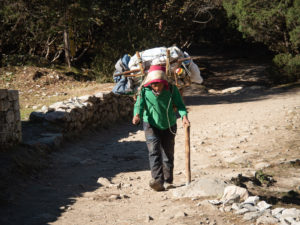 It can also be used as a walking stick.
It can also be used as a walking stick.
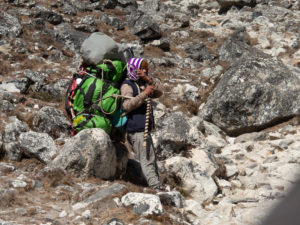 Resting on a rock. He has quite a load.
Resting on a rock. He has quite a load.
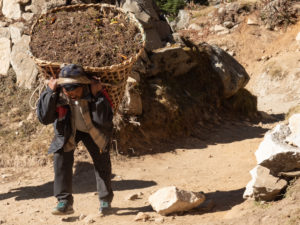 Hauling dirt? As we got higher there were many folks hauling yak dung for fuel as trees became extinct at higher elevations.
Hauling dirt? As we got higher there were many folks hauling yak dung for fuel as trees became extinct at higher elevations.
The last four images are a reminder of what their “office” looks like each day. I can only imagine the stress their bodies endure with these loads crushing down on their spines. It’s a necessary evil to live and thrive at these locations. Our impact on the land and these people is certainly something to think about.
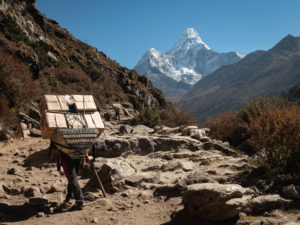
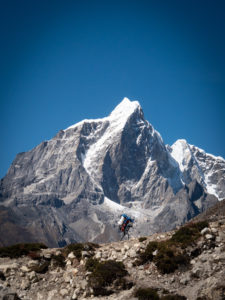
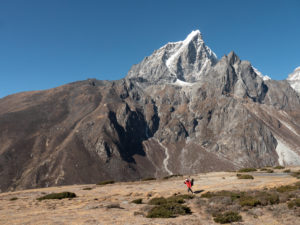
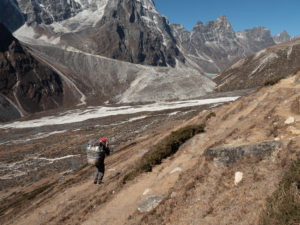
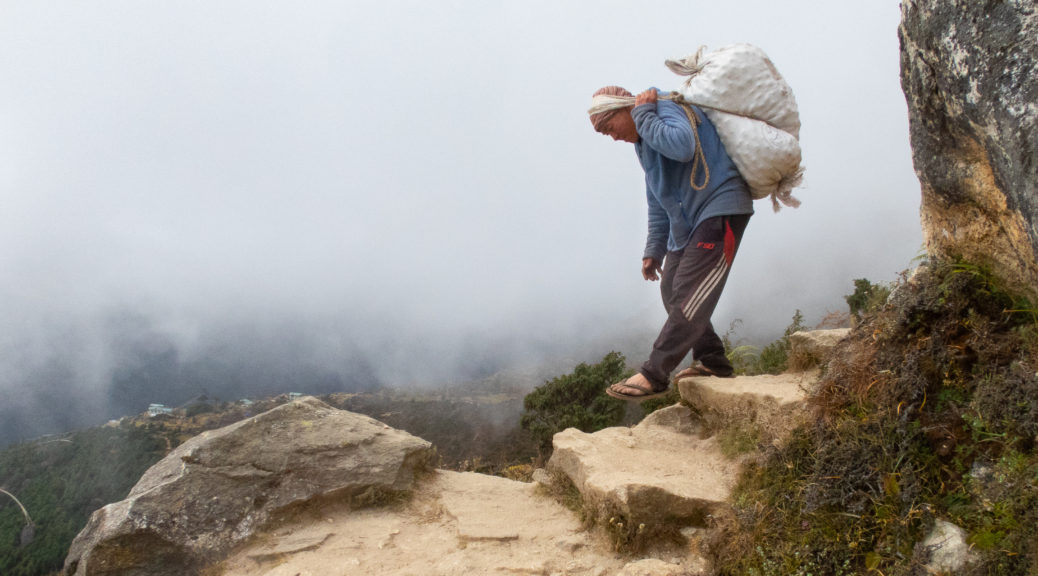
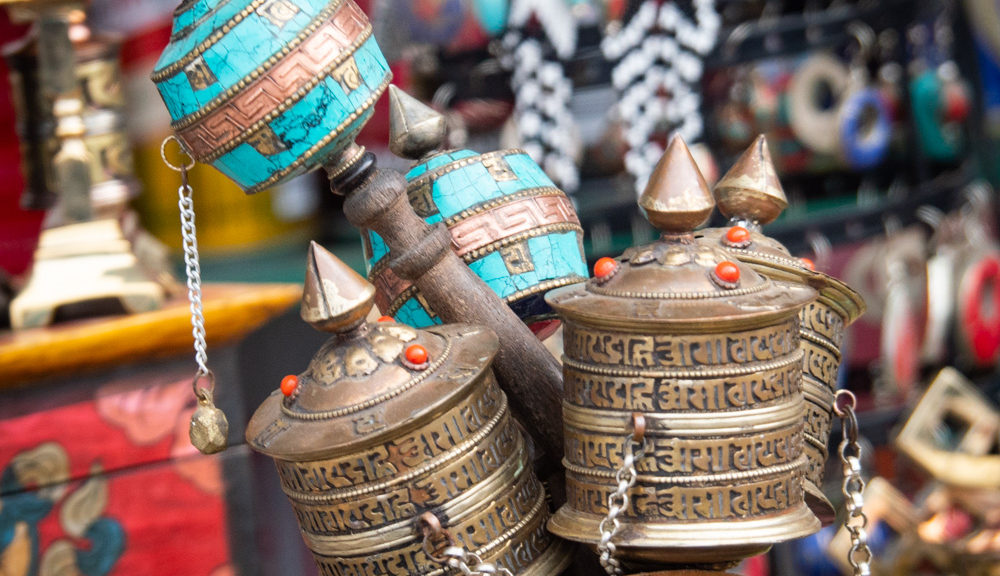
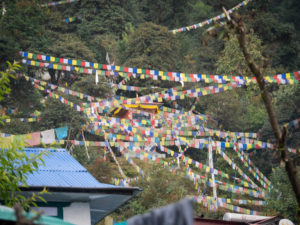
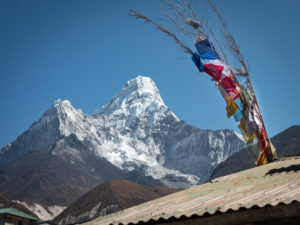
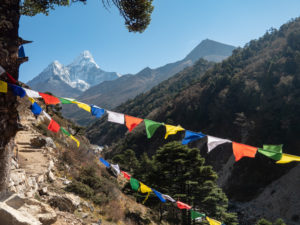
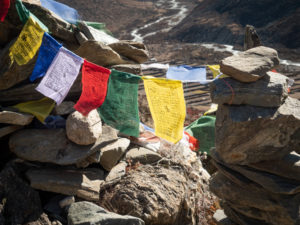
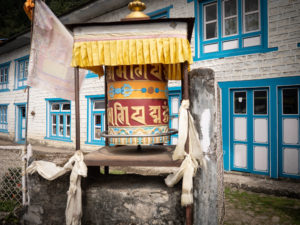
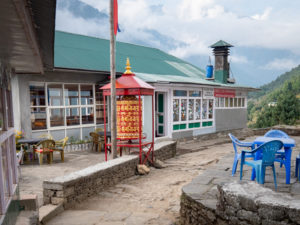
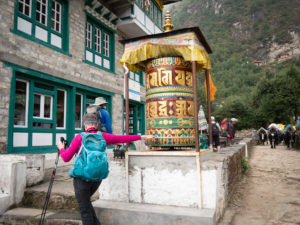
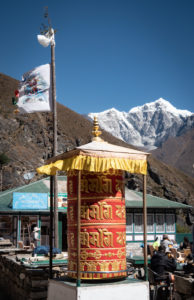
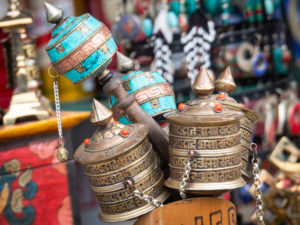
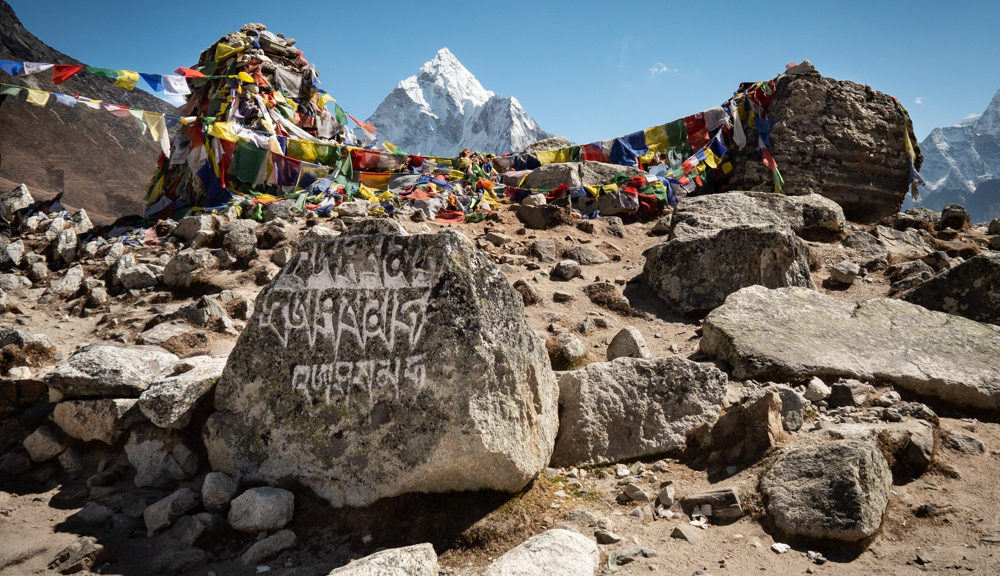
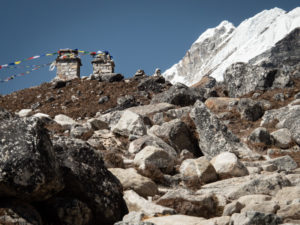
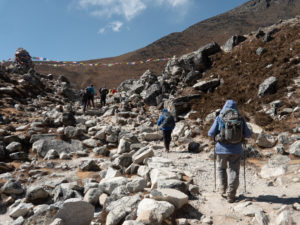
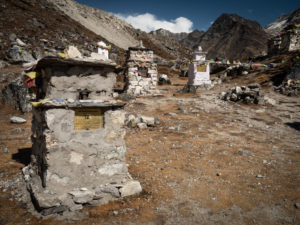
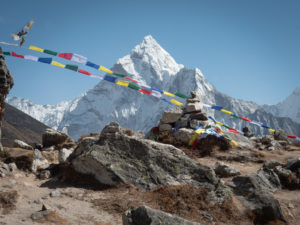
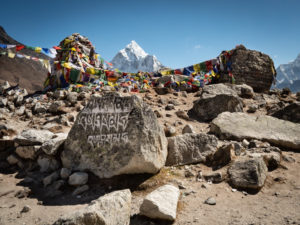
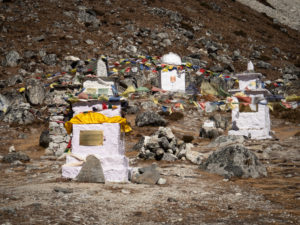
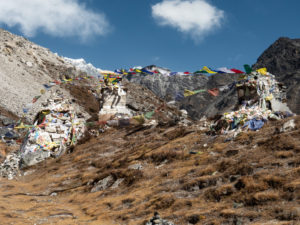
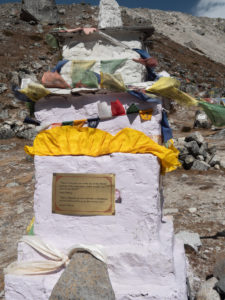
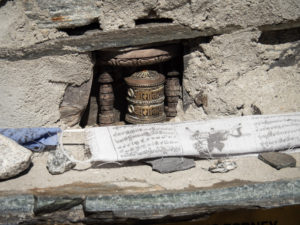
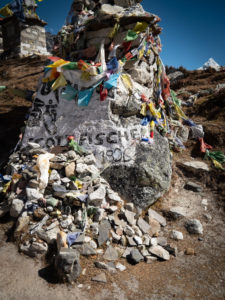 This is the memorial to Scott Fischer, one of ten climbers lost in 1996 in one storm. The movie
This is the memorial to Scott Fischer, one of ten climbers lost in 1996 in one storm. The movie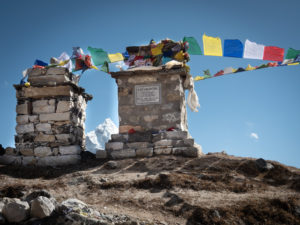
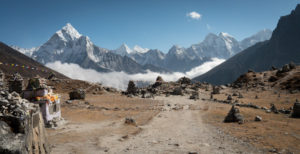 This is the valley of the monuments. Just LOOK at the surrounding mountains. This pass is at 15,846 feet with mountain peaks jutting into the sky another 10,000 feet or so.
This is the valley of the monuments. Just LOOK at the surrounding mountains. This pass is at 15,846 feet with mountain peaks jutting into the sky another 10,000 feet or so.
 This is the bathroom at our first tea lodge. We gave it a five-star as it had these qualities: “western” toilet, shower head AND sink. The amazing thing is that these were all in our room!! The miracle of this would be realized at lodges further up the trail.
This is the bathroom at our first tea lodge. We gave it a five-star as it had these qualities: “western” toilet, shower head AND sink. The amazing thing is that these were all in our room!! The miracle of this would be realized at lodges further up the trail.
 Here is where we began making the transition. No toilet seat or ability to flush as we’re used to. To flush one had to fill the bucket and pour it in.
Here is where we began making the transition. No toilet seat or ability to flush as we’re used to. To flush one had to fill the bucket and pour it in.



 And then there were the fake hybrids. You can see the tank that we think was just there for show, the bucket for paper waste and the cup to wash down your business.
And then there were the fake hybrids. You can see the tank that we think was just there for show, the bucket for paper waste and the cup to wash down your business.




 One of the first examples of what we came to call prayer rocks showed up on this massive wall upon our descent into Sagarmatha National Park. Initially, we thought the words were painted on.
One of the first examples of what we came to call prayer rocks showed up on this massive wall upon our descent into Sagarmatha National Park. Initially, we thought the words were painted on. Upon closer examination, we realized they were etched out of the stone. In other words, the words rose above the background of rock. We assumed it was the monks that did it but never confirmed that.
Upon closer examination, we realized they were etched out of the stone. In other words, the words rose above the background of rock. We assumed it was the monks that did it but never confirmed that. This rock is in the village of Lukla.
This rock is in the village of Lukla. This is one of the few we encountered using various colors. This is at the monastery in Tengboche.
This is one of the few we encountered using various colors. This is at the monastery in Tengboche.

 This one is heading into Dingboche.
This one is heading into Dingboche.
 At times the tablets were just piled into a heap resembling a stupa. A stupa is a Buddhist commemorative monument usually housing sacred relics associated with the Buddha or other saintly persons. The hemispherical form of the stupa appears to have derived from pre-Buddhist burial mounds in India.
At times the tablets were just piled into a heap resembling a stupa. A stupa is a Buddhist commemorative monument usually housing sacred relics associated with the Buddha or other saintly persons. The hemispherical form of the stupa appears to have derived from pre-Buddhist burial mounds in India.

 The eyes of Buddha.
The eyes of Buddha. This is a stupa outside the monastery in Tengboche.
This is a stupa outside the monastery in Tengboche. This is a monument built to remember some climbers who lost there lives on Lhotse, the fourth tallest mountain on Earth.
This is a monument built to remember some climbers who lost there lives on Lhotse, the fourth tallest mountain on Earth. These guys were outside the monastery in Tengboche.
These guys were outside the monastery in Tengboche. Here is a post with intricate carvings on it.
Here is a post with intricate carvings on it. Here’s a stupa base with carvings.
Here’s a stupa base with carvings. This statue was outside our tea lodge in Gorakshep.
This statue was outside our tea lodge in Gorakshep. These paintings were inside a small structure at the entrance to the village of Tengboche.
These paintings were inside a small structure at the entrance to the village of Tengboche.
 On the main thoroughfare, one can purchase trekking poles, water bottles, backpacks, jackets, maps and more.
On the main thoroughfare, one can purchase trekking poles, water bottles, backpacks, jackets, maps and more.  Yak tails showed up occasionally. Not sure why.
Yak tails showed up occasionally. Not sure why. These canisters are for locals and expeditions alike. They are propane tanks for heating and cooking. This type of broom is commonly used throughout Kathmandu and the trek.
These canisters are for locals and expeditions alike. They are propane tanks for heating and cooking. This type of broom is commonly used throughout Kathmandu and the trek. One can purchase a commemorative t-shirt, mala beads or Hindu masks.
One can purchase a commemorative t-shirt, mala beads or Hindu masks.






 The eyes of Buddha are everywhere.
The eyes of Buddha are everywhere. Trinkets were for sale all along the trail. We saved most of our souvenir buying for Kathmandu so as to save on space and weight on the hike.
Trinkets were for sale all along the trail. We saved most of our souvenir buying for Kathmandu so as to save on space and weight on the hike. 
 This one might win the most solid award. And it was quite scenic with the trees and building.
This one might win the most solid award. And it was quite scenic with the trees and building. This is a suspension bridge with yaks on it. We were warned that if we encountered yaks on a bridge to back up so as not to get accidentally gored. We never encountered any but saw plenty from a distance.
This is a suspension bridge with yaks on it. We were warned that if we encountered yaks on a bridge to back up so as not to get accidentally gored. We never encountered any but saw plenty from a distance.

 The view from the tall ones was spectacular. The movement in the bridge from hikers and wind only added to the excitement.
The view from the tall ones was spectacular. The movement in the bridge from hikers and wind only added to the excitement. This suspension bridge was destroyed in the 2015 earthquake that rocked Nepal. Let’s hope no one was on it when it collapsed.
This suspension bridge was destroyed in the 2015 earthquake that rocked Nepal. Let’s hope no one was on it when it collapsed. This is a decommissioned bridge down by the river.
This is a decommissioned bridge down by the river. Most of the bridges were at water level. This one is a classic example of having to hike down to the river only to hike right back up again.
Most of the bridges were at water level. This one is a classic example of having to hike down to the river only to hike right back up again. We appreciated the smallest of bridges and dry feet!
We appreciated the smallest of bridges and dry feet! Heading to a suspension bridge. We could always count on a little surge of adrenaline as we approached such structures.
Heading to a suspension bridge. We could always count on a little surge of adrenaline as we approached such structures.
 A more solid and permanent structure along the way. We would head up the stairs and pass those yaks coming down.
A more solid and permanent structure along the way. We would head up the stairs and pass those yaks coming down.


 This is a yak herder’s hut. You can see another one in the background.
This is a yak herder’s hut. You can see another one in the background.




 Here are a couple of young men playing a game in Dingboche.
Here are a couple of young men playing a game in Dingboche. Fixing a bowl of potatoes.
Fixing a bowl of potatoes. Holding hand as they approach steps in Lukla.
Holding hand as they approach steps in Lukla. Tourism is clearly the leading industry in the region. There is a lot of waiting for patrons to enter the shops.
Tourism is clearly the leading industry in the region. There is a lot of waiting for patrons to enter the shops.

 This lady looks like she’s standing in a telephone booth. Cell phone coverage was pretty constant throughout the trek.
This lady looks like she’s standing in a telephone booth. Cell phone coverage was pretty constant throughout the trek. We passed this woman closing her gate as we passed in a small village somewhere along the trail.
We passed this woman closing her gate as we passed in a small village somewhere along the trail.
 The kids were great. We would get waves from windows or they would approach us saying “Namaste”.
The kids were great. We would get waves from windows or they would approach us saying “Namaste”. The exchange of money was cool to watch. There were no coins to speak of. What seemed like a lot of rupees really wasn’t. Ten rupees was really a little over eight cents, not ten dollars.
The exchange of money was cool to watch. There were no coins to speak of. What seemed like a lot of rupees really wasn’t. Ten rupees was really a little over eight cents, not ten dollars. The guy in yellow is getting a helping hand with washing his hair. I’m guessing this means there is no running water in the home.
The guy in yellow is getting a helping hand with washing his hair. I’m guessing this means there is no running water in the home. I thought this was daughter braiding mom’s hair.
I thought this was daughter braiding mom’s hair. We sat with this lady for a while. She had a very active grandson.
We sat with this lady for a while. She had a very active grandson. This little guy couldn’t have been more than three or four years old. He was one of the few children we saw at the upper end of the trek.
This little guy couldn’t have been more than three or four years old. He was one of the few children we saw at the upper end of the trek. We spent the most time in Dingboche. This woman was working in her yard or yak pen as we passed by.
We spent the most time in Dingboche. This woman was working in her yard or yak pen as we passed by. A common sight in this region, people using carrying baskets held from their heads. There were a lot of children in Lukla and less and less the higher we got.
A common sight in this region, people using carrying baskets held from their heads. There were a lot of children in Lukla and less and less the higher we got.
 This is Dilip and Nutan making sure it was ours. We climbed aboard, women and gear first, to be ferried down to Pheriche. We couldn’t all fly together at the altitude of Gorakshep or the chopper couldn’t take off. So we were taken first then waited for the guys to show up.
This is Dilip and Nutan making sure it was ours. We climbed aboard, women and gear first, to be ferried down to Pheriche. We couldn’t all fly together at the altitude of Gorakshep or the chopper couldn’t take off. So we were taken first then waited for the guys to show up. Here’s the view from the hill looking up the valley toward base camp.
Here’s the view from the hill looking up the valley toward base camp. Here’s Nutan following his first ever helicopter ride. His face says it all!
Here’s Nutan following his first ever helicopter ride. His face says it all! We had the only female pilot in the Khumbu region. If you look closely you can see the oxygen cannula under her nose. Coming from probably Kathmandu and 4,000 feet she needed it to not pass out at the higher altitudes. We were pretty glad she had it.
We had the only female pilot in the Khumbu region. If you look closely you can see the oxygen cannula under her nose. Coming from probably Kathmandu and 4,000 feet she needed it to not pass out at the higher altitudes. We were pretty glad she had it. Dingboche and the yak pens.
Dingboche and the yak pens. Tengboche Monastery.
Tengboche Monastery. Then we all got on board and flew to Lukla!
Then we all got on board and flew to Lukla! The helipad in Lukla is just the other side of the runway. Here is another helicopter coming in for a landing.
The helipad in Lukla is just the other side of the runway. Here is another helicopter coming in for a landing. And this is the helicopter terminal! Here’s what’s amazing…all that hiking we did for 12 days was made in a 20-minute helicopter ride. 20 MINUTES!!
And this is the helicopter terminal! Here’s what’s amazing…all that hiking we did for 12 days was made in a 20-minute helicopter ride. 20 MINUTES!!